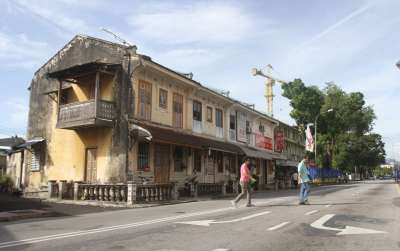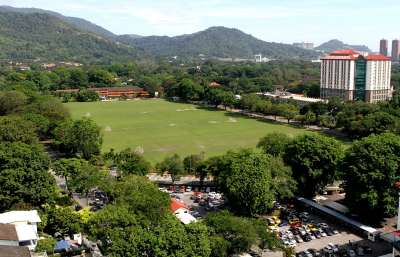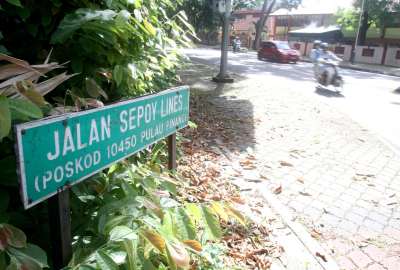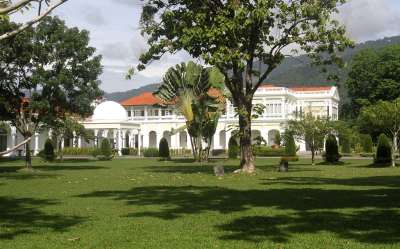 Old architecture: Cantonment Road in Pulau Tikus was probably named after an army camp in the area. It intersects with Burmah Road and Kelawei Road.
Old architecture: Cantonment Road in Pulau Tikus was probably named after an army camp in the area. It intersects with Burmah Road and Kelawei Road. GUNS, cannons, bullets and mercenaries — these were the essentials in old Penang and a number of roads have kept these memories alive.
Magazine Road was named after the government gunpowder depot, which was formerly located at the present Gama supermarket.
According to Boon Raymond, who blogs about the streets of Penang, the Chinese used to call Magazine Circus as Goh Pha Teng to refer to the “five arms gas lamps” that stood there.
To the older Penangites, it was also commonly known as Cheng I-Oh Keng which means gunpowder store or armoury.
Little information is available on the functions of the armoury but Penang must have been some kind of a cowboy town.
Then, there is Cannon Square, near Khoo Kongsi, where a cannon shot was fired during the secret society fights known as the Penang Riots of 1867.
 Park for all: Polo Ground is popularly used for football matches.
Park for all: Polo Ground is popularly used for football matches. The one personality who found his place in history, and on the streets of Penang, was businessman Khoo Thean Teik — of which Thean Teik Road was named after.
Thean Teik, literally translated as “heavenly virtues”, was said to be the leader of a notorious triad.
At the age of 34, he established himself as the Big Brother or tai kor, and when the riots broke out, he was convicted for instigating them.
At that time, he was also a director of the Khoo Kongsi, the clan house of the Khoos, but that did not stop the authorities from sentencing him to death.
But Khoo had enough clout and influence. The British colonial government feared that his execution would led to another riot and quickly reduced it to life imprisonment. But he was released after seven years.
He made his fortune and prospered by buying up vast tracts of land at what is now known as Thean Teik Estate.
 Honoured : Sepoy Lines Road is a tribute to the Indian soldiers brought in by the British.
Honoured : Sepoy Lines Road is a tribute to the Indian soldiers brought in by the British. Much of the money came from immigrant labour trading and opium distribution, permitted by the British. In Perak, he was involved in gaming and pawn-broking, which made him even richer.
Given the circumstances in old Penang, the British realised it had to beef up its army to ensure peace, or rather, control over its territory.
Sepoy Lines Road, located opposite the Penang General Hospital, was where Indian soldiers hired by the British colonial government used to stay.
They were known as Sepoys, a Persian word for infantry soldiers, in the Mughal Empire and in the 18th century, they were hired by the British East India Company, which was then making its foray into the East.
In one entry in Wikipedia, it claimed that over 80% of the East India Company’s 300,000-strong army were from India.
 Sprawling grou nds: The overall architecture style of Seri Mutiara hardly changed since the 1890s.
Sprawling grou nds: The overall architecture style of Seri Mutiara hardly changed since the 1890s. In Penang, the barracks of the Sepoys were located there while the British soldiers stayed at the nearby Barracks Road, near where the Penang Prison is.
Not far from Sepoy Lines Road, is Cantonment Road located in the district of Pulau Tikus.
As the name suggests, there used to be an army cantonment or camp there.
But it is the Polo Ground field adjacent to Sepoy Lines Road that is of interest as a landmark to Penangites.
Located in front of the Seri Mutiara — the Penang Governor’s residence — the field was reportedly created around the late 19th century.
It is said that it was originally planned to be a parade ground after the military barracks were moved from Fort Cornwallis at the Esplanade to the present Barracks Road and Sepoy Lines Road.
The man put in charge of the shift was one Captain Tristram Charles Sawyer Speedy — who was said to have planted the baobab tree in 1871 at the junction of Residency Road and Macalister Road or more precisely, outside St George’s Girls School.
Little was written about Captain Speedy with one report describing him as a soldier of fortune, who recruited Sikh soldiers for the Company.
As I carried out the research on this topic, I came across a write-up that the junction used to be called the Piccadilly Circus, after the one in London.
The baobab tree is native to Africa and Australia and today, the tree still stands there now, supported by a wooden stand to prevent it from collapsing.
The baobab tree is known as the tree of life, with good reason. It provides shelter, clothing, food, and water for the animal and human inhabitants of the African region.
With the field’s proximity to the Penang Turf Club, where the horses are kept, it was also used for a game of polo, which was probably how its name came about.
Horses are still seen walking along the road but the polo games seemed to have disappeared.
Instead today, Penangites have used the field for their afternoon exercise and football games.
The open field is still used by the army to airlift patients on mercy flights as the hospital is located opposite.
But until the early 1990s, when the field was sealed off to cars, a section of the field, near the Penang Club, was a lovers’ haunt in the evenings.
Penangites would jokingly point to the kereta rosak — or “broken down” cars — parked in rows in the evenings.
Occasionally, there would be embarrassing situations when eager lovers, or simply bad drivers, would drive their vehicles into small trenches surrounding the field.
Unable to get their cars out of the tricky situation, they often had wait until the next morning for the tow trucks to help them out.
But Penang being such a small town then, a car stuck in the field would be seen by many on their way to work, who happened to pass by Polo Ground!
For the raunchy motorcyclists, it was not uncommon to take their girlfriends right to the middle of the field, where they could not be seen from the adjoining roads, as it was dark enough to have a bit of fun in public.
Workers would often pick up evidence strewn all over the field the next morning.
This writer is not writing from experience but from someone with observant eyes.
Another lovers’ haunt — until it was closed to cars — was the Botanical Gardens where much monkeying around took place in the nights!
It was common for teenagers to drive through the garden purportedly to look for their friends’ cars and the more nasty ones would alight from their cars to knock on the windows of their friends’ vehicles!
I guess the terms “Guns and Roses” came very much early to Penang — where guns, triad fights and romance provided the glamour and colour to that era.





